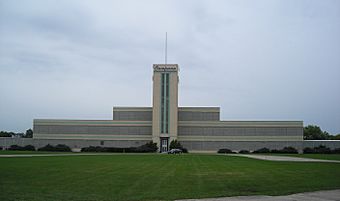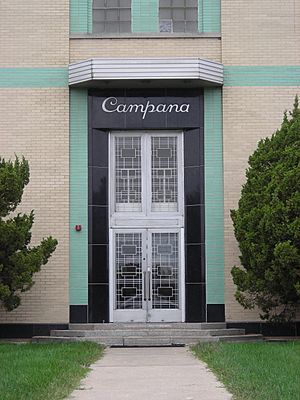Campana Factory facts for kids
Quick facts for kids |
|
|
Campana Factory
|
|
 |
|
| Location | Roughly along Illinois Route 31 and Fabyan Pkwy., Batavia, Kane County, Illinois, United States |
|---|---|
| Built | 1936 |
| Architect | Frank D. Chase; Childs and Smith |
| Architectural style | Streamline Moderne, Bauhaus |
| NRHP reference No. | 79000841 |
| Added to NRHP | April 6, 1979 |
The Campana Factory is a special old building in Batavia, Illinois. It was built in 1936 for The Campana Company. This company made Italian Balm, a very popular hand lotion. It was especially popular during The Great Depression, a time when many people faced tough economic challenges.
This factory is a great example of Streamline Moderne and Bauhaus styles. These were popular building styles from the past. The building also had many new technologies for its time. For example, it was one of the first buildings to have air conditioning. The Campana Factory was added to the National Register of Historic Places in 1979. This means it is an important historical site.
The Story of Campana
The Campana Company made hand lotion, like their famous Italian Balm. They also made other beauty products. Even during The Great Depression, when money was scarce, Campana did very well. They were successful because they advertised a lot on the radio. Their commercials were on many popular shows, like The First Nighter Program.
Campana also sent millions of free samples to people. This helped them get many new customers. The company was so successful that they needed a brand new factory. They decided to build it in 1936. The new factory was designed to show off the latest technology and building styles. This helped promote their products even more.
Building Design and Features
The Campana Factory was inspired by the Bauhaus and Art Deco building styles. It was three stories tall. A central tower rose about 100 feet (30 meters) into the sky. The building itself was long and wide. The third floor was shorter than the other two.
The building used a mix of tile and glass brick instead of regular windows. These glass bricks let light into the building. They did not need vertical dividers called mullions. Horizontal stripes of turquoise tile wrapped around the building. Vertical stripes went up the tower. The Campana company logo was written in gold leaf above the main door. A large, red neon sign showed the logo near the top of the tower.
Inside the Factory
Inside, fluorescent lights lit up areas away from the glass bricks. Most walls were painted white or covered in tiles. The east side of the building had a special visitors' gallery. Here, Campana leaders could give tours. Visitors could see the factory at work without bothering the employees. Large plate glass windows separated the tour area from the manufacturing floor.
The tower inside held a huge 50,000-gallon (189,270-liter) water tank. This water was used for fire protection. It also supplied the building's air conditioning system. The Campana Factory was one of the first buildings to have full air conditioning. Because of this, they didn't think they needed windows that could open. So, no opening windows were ever added.
The factory had modern assembly lines and mixers. These machines were considered very advanced. Cosmetic ingredients were dropped from the third floor to the second floor for mixing. The company also moved its main offices into the new building. Desks were placed in long rows to save space. This was a new idea back then, but it's very common today.
Later Years
In the 1940s, a glass block section was added to each end of the first floor. This was the only major change to the factory. In the early 1960s, Dow Chemical bought The Campana Company. Campana continued to operate as a separate business.
Later, Purex bought Campana in the mid-1960s. After the Campana president retired in the mid-1970s, Purex moved all operations out of Illinois. The factory then closed down. The building was added to the National Register of Historic Places on April 6, 1979. Today, the old factory is home to All Dressed Up Costumes.




